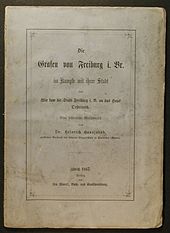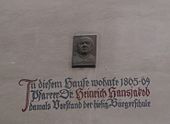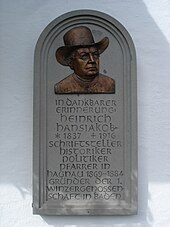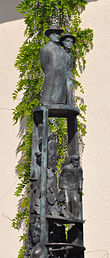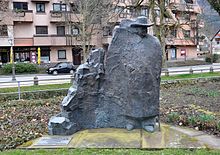Heinrich Hansjakob
Heinrich Hansjakob (born August 19, 1837 in Haslach ; † June 23, 1916 ibid) (pseudonym: Hans am See) was a Catholic clergyman, native Baden writer, historian and politician. Hansjakob was best known as a writer. In addition to scientific works, political writings and travel reports , he wrote short stories and novels , which mainly deal with the local history of the Middle Black Forest and the mentality of the people in this area.
Life
Haslach time
Heinrich Hansjakob was born as the son of the baker and host Philipp Hansjakob and his wife Cäcilie née Kaltenbach in Haslach in the Kinzig valley. His mother came from the Rohrbach district of Furtwang . On his father's side, the Hansjakob family had lived on the Kinzig since the Thirty Years' War . From 1852 to 1859 he attended the high school in Rastatt . He then studied theology , philosophy and classical philology at the University of Freiburg . In 1863 he was ordained a priest. In 1865 he received his doctorate in Tübingen with a historical treatise on the Counts of Freiburg.
Donaueschingen and Waldshut time
After completing his studies, from January 20, 1864, he was initially a teaching trainee (student trainee) at the Donaueschingen grammar school for a year , where he made friends with the Fürstenberg archivist Karl Roth von Schreckenstein and the librarian Karl August Barack ; his dissertation, The Counts of Freiburg im Breisgau in conflict with their city . In 1865 he was promoted to Waldshut as a director of the higher citizen school. From Waldshut he ran his own household with his sister Philippine. During his time in Waldshut, he published the text Die Salpeterer , a political-religious sect, and the biography of Hermann von Vicari , Archbishop of Freiburg, in Advent 1866 . Both writings called the authorities to the scene. The latter was confiscated and banned. In 1869 he therefore resigned from his position as director of the community school. Since he now felt more free, he expressed himself critical of the government under Minister Jolly in a speech in Engen , whereupon he served a month's imprisonment in the Rastatt fortress for insult . Here he wrote the book On the fortress . The booklet Der Waldshut War of 1468 was also created during his time in Waldshut ; it appeared in 1868.
Pastor in Hagnau on Lake Constance
On December 1, 1869, the auxiliary bishop Lothar von Kübel transferred him to Hagnau on Lake Constance at his own request. From 1869 to 1883 he was a Catholic pastor in Hagnau on Lake Constance . As a “water doctor at the lake”, he advised patients to moderate their lifestyle, moderate water applications and compresses. Viticulture in Hagnau was threatened by part-time farming, pest infestation by powdery mildew and the harsh winter of 1879/1880 . That is why Hansjakob founded the Hagnauer Winzerverein on October 20, 1881 , thereby helping to save the traditional viticulture on Lake Constance . The winegrowers 'association was the first winegrowers' cooperative in Baden. He still has Hansjakob's image in his logo today . From 1871 to 1881 he was also a member of the Catholic People's Party in the Baden state parliament . In 1873 he was imprisoned in Radolfzell for six weeks for insulting a state official . In the same year his first son was born, whereupon Hansjakob visited a neurologist - we know of a total of four illegitimate children. Between 1874 and 1879 he traveled to France, Italy, Austria, Belgium and the Netherlands. In 1878 there was a falling out with his party.
Pastor in Freiburg in Breisgau
In 1884 he took up a position as pastor of the St. Martin's Church in Freiburg , which he held until 1913 despite disputes with the church authorities.
Hansjakob had a disposition to nervous disorders and suffered from mood swings. For the treatment he stayed for several months in 1894 in the mental hospital Illenau on in Achern. He fought his symptoms ("nerve devils") with opiates . According to Beck / Froneberg (2015), he remained heavily dependent on medication and barely able to work.
From 1897 he lived in the former Freiburg Charterhouse , which at that time had already been rededicated as a beneficiary house , a residential and retirement home for 200 beneficiaries , i.e. pensioners who had acquired the right to move in and looked after through a legacy become.
Freihof in Haslach
After his retirement he had the Freihof in his hometown Haslach built in the form of a farmhouse. He lived there from October 22, 1913 until his death on June 23, 1916. The Freihof was preserved as a museum.
Heinrich Hansjakob died on June 23, 1916 at the age of 78 in his birthplace. He was buried in the crypt of his grave chapel in nearby Hofstetten, which was built during his lifetime by the good friend and architect Max Meckel and the sculptor Joseph Dettlinger .
Act
writer
Heinrich Hansjakob wrote over 70 books and writings.
In his works Hansjakob used anti-Semitic topoi and clichés several times . Despite his admiration for the Jewish religion and its Old Testament tradition, on the one hand, his publications contain contemptuous sentences about Jews. His biographer Manfred Hildenbrand warned against playing down Hansjakob's derogatory judgments about “the” Jews. Because as a well-read author, he influenced public opinion.
Commitment to folklore and traditions
He campaigned for the respect and preservation of the Alemannic dialect . As chairman of the Freiburg Trachtenverein, he campaigned for the wearing of national costumes.
Social reformer
He founded Baden's first wine cooperative in Hagnau on Lake Constance . In Freiburg on Rathausplatz and at St. Martin's Church , he had arcades set up for small business people.
Image of women
Hansjakob turned against the emancipation of women and spoke up u. a. against active and passive voting rights, high school education and university studies for women. He argued that women should receive basic schooling, but otherwise should be housewives. At the same time, he attested women the ability to make sacrifices and the ability to develop fundamentally in accordance with their dispositions in the life process.
Afterlife
Commemoration
- In Hagnau several monuments were erected in his honor: a plaque on his house, a statue at the city hall, scenes snowball fountain in the center and a statue of Peter Lenk in the grounds of private Burgundy court.
- In 1980 a former monastery was named after him in Freiburg, today's Heinrich-Hansjakob-Haus.
- At the Capuchin monastery in Haslach in the Kinzig valley there is a sculpture in memory of Heinrich Hansjakob.
- In addition, numerous schools and educational institutions were named after Heinrich Hansjakob. For example, the education center in Haslach bears his name, as does the Heinrich Hansjakob Realschule in nearby Elzach. In Freiburg there is a Hansjakob secondary school in Stühlinger . In Waldshut there is the Heinrich Hansjakob School.
- In many cities there is a Hansjakobstrasse.
In museums
The Hagnauer Museum in Hagnau houses a collection of his books, stories, travel memories, sermons and political writings. His services as the founder of the Hagnauer Winzerverein are also documented there. The significance of his large felt hat ( "grand chapeau", " Heckerhut ") is explained as follows: All that the democratic ideas of Friedrich Hecker held, wore this hat with the wide brim. The makers of his first hats lived right next to his parents' house.
In Haslach im Kinzigtal , the Freihof, which he built in 1913 as a retirement home in the Black Forest style, is now a Hansjakobmuseum. You can also see pictures of the Black Forest by Curt Liebich and Heinrich Hoffmann , all of the books he wrote, his library, the stages in his life and his hat. On the occasion of his 175th birthday, a memorial ceremony took place there on August 19, 2012. When the Hansjakobmuseum was redesigned from 2012–2014, the Hansjakobarchiv was transferred from Freihof to the Haslach i. K. relocated.
A Heinrich Hansjakob memorial with three originally preserved rooms was housed in the Freiburg Charterhouse . In 2012 the Literature Museum was closed at the instigation of the Robert Bosch Foundation .
In libraries and archives
The discount Hans Jacob is in the Baden State Library in Karlsruhe kept. It contains u. a. Letters and manuscripts for works, diaries, sermons, etc.
Through companies
The Heinrich Hansjakob Society in Freiburg publishes publications about him and his contemporaries. The winegrowers 'association in Hagnau points to him as the founder of the winegrowers' cooperative.
Hansjakobwege
Two hiking trails in the central Black Forest are named after Heinrich Hansjakob : the Große Hansjakobweg (four-day circular hiking trail from Haslach back to Haslach) and the Kleine Hansjakobweg (three-day circular hiking trail with Schapbach as the starting and finishing point). Both paths are maintained and looked after by the Black Forest Association. Numerous information boards along the way familiarize the hiker with the scenes of the stories Hansjakob and his youth.
Works (selection)
Great narratives
- The ship of fools of our time by Hans am See, Mainz 1873 (based on the ship of fools by Sebastian Brant )
- The Snowball Cycle (The title Snowball was chosen by Hansjakob based on the “Three Snowball” inn in Hofstetten near Haslach.)
- Snowballs, first and second rows , 1892; New edition: ISBN 978-3-87407-926-6 (first row), ISBN 978-3-87407-927-3 (second row)
- Snowballs, third row , 1893. New edition 1911 published by Adolf Bonz & Comp. Stuttgart. New edition in 2002 by Waldkircher Verlagsgesellschaft, Waldkirch, ISBN 978-3-87407-920-4 . (Events during the time as pastor of Hagnau 1869–1884).
stories
- The Waldshut War of 1468. Examined and presented for four hundred years of memory . Printed and published by Heinrich Zimmermann, Waldshut 1868 ( digital copy from the Bavarian State Library)
- From my youth , 1880. Reprinted by Hansjakob-Verlag der Stadt Haslach, 16th edition 1986, Haslach im Kinzigtal. (Memories of the youth of Hansjakob and description of the revolution 1948/49 in the Kinzig valley).
- Memories of an Old Hat , 1882
- From my student days , 1885
- Wild cherries , 1888. Reprinted by Hansjakob-Verlag der Stadt Haslach, 17th edition 1992, Haslach im Kinzigtal. (Nine stories about the people in the Black Forest)
- Der Leutnant von Hasle , 1895. Reprint in the Hansjakob-Verlag der Stadt Haslach, 15th edition 1978, Haslach im Kinzigtal. (Story from the Thirty Years War ).
- Bauernblut , 1896. Reprinted by Hansjakob-Verlag der Stadt Haslach, 16th edition 2002, Haslach im Kinzigtal. (Five stories about the Black Forest homeland).
- Forest people , 1897. Reprinted by Hansjakob-Verlag der Stadt Haslach, 13th edition 1997, Haslach im Kinzigtal. In it the three stories:
- The prince of the Teufelsstein
- Theodor, the soap boiler
- Afra
- The stone man of Hasle , 1897. Reprinted by Hansjakob-Verlag der Stadt Haslach, 7th edition 1981, Haslach im Kinzigtal. (Novel about Count Götz von Fürstenberg-Haslach and the Middle Ages).
- Memories of an old woman from the Black Forest , 1898. Reprinted by Hansjakob-Verlag der Stadt Haslach, 15th edition 2004, Haslach im Kinzigtal. (Life story of Hansjakob's grandfather).
- Erzbauern , 1899. Reprint in the Hansjakob-Verlag der Stadt Haslach, 12th edition 2002, Haslach im Kinzigtal. (Four stories about the farmers of the Kinzig valley and the social upheavals caused by industrialization).
- From the life of an unfortunate man , 1900
- From the life of a happy man , 1901
- From the life of a well-tried , 1903
- My Madonna , 1903
- From the Life of a Beloved One , 1909; New edition: ISBN 978-3-87407-924-2
- From the life of a faithful housemate , 1909; New edition: ISBN 978-3-87407-923-5
- The Vogt on Mühlstein . Reprint in the Hansjakob publishing house of the city of Haslach, 1st reprint in 2006, Haslach im Kinzigtal. (Tragic story of Magdalena, daughter of the bailiff on Mühlstein).
Travel memories
- In France , 1874 ( digitized )
- In Italy , 1877
- In the Netherlands , 1881
- Abandoned Paths , 1902; New edition: ISBN 978-3-87407-911-2 (life of the farmers and townspeople of the Elz- and Simonswäldertal)
- Last trips , 1902; New edition: ISBN 978-3-87407-912-9
- Summer trips , 1902; New edition: ISBN 978-3-87407-913-6
- Alpine roses with thorns , 1905; New edition: ISBN 978-3-87407-914-3
- Sunny Days , 1906; New edition: ISBN 978-3-87407-915-0
- In Belgium , 1915
Diaries
- At the fortress , 1870
- In prison , 1873
- In the residence , 1878; New edition: ISBN 978-3-87407-948-8
- Drought leaves, first row , 1889
- Drought leaves, second row , 1890
- From Sick Days , 1895; New edition: ISBN 978-3-87407-947-1
- Im Paradies , 1897. Reprinted by Hansjakob-Verlag der Stadt Haslach, 7th edition 2002, Haslach im Kinzigtal. (Diary from 1896 with an opinion on problems of the time).
- Evening bells , 1900; New edition: ISBN 978-3-87407-951-8
- In the Charterhouse , 1900; New edition: ISBN 978-3-87407-917-4
- Silent Hours , 1903; New edition: ISBN 978-3-87407-918-1
- My grave , 1905
- All Souls Day , 1912; New edition: ISBN 978-3-87407-919-8
- All kinds of people and all kinds of thoughts , 1913
- Closing time , ed. by Anton Trunz, 1918
Political Writings
- Our national costumes . Herder, Freiburg im Breisgau 1892. - In addition, critical: Richard Nuzinger : The preservation of the national costumes. A warning . H. Specht, Zell im Wiesental n.d. [1896], 2nd, increased edition: Comtesse, Heidelberg 1897.
literature
(alphabetically by authors)
- Andreas Beck, Michael Froneberg: Hansjakob. Thoughts about his suffering. Heinrich Hansjakob Society, Freiburg 2015. ISBN 978-3-946254-08-9
- Helmut Bender: Hansjakob and Freiburg. Waldkirch: Waldkircher Verlagsgesellschaft 1986. (= Badische Reihe; 17) ISBN 3-87885-123-5
- The folk writer Heinrich Hansjakob. Marginalia to a Black Forest original. Waldkirch: Waldkircher-Verl. 1990. ISBN 978-3-87407-930-3
- Heinz Bischof: Anecdotes about Hansjakob. Kehl u. a .: Morstadt 1981. ISBN 3-88571-033-1
- Joachim Faller: Heinrich Hansjakob. In: Biographisch-Bibliographisches Kirchenlexikon (BBKL). Volume 23, Bautz, Nordhausen 2004, ISBN 3-88309-155-3 , Sp. 611-617.
- Oswald Floeck: Heinrich Hansjakob. A picture of his intellectual development and literature. Karlsruhe u. a .: Gutsch 1921.
- Hansjakob-Verlag der Stadt Haslach (Ed.): Dr. Heinrich Hansjakob, pastor, politician, writer. A brief outline of his life. EH-Druck, 77716 Haslach, 2000.
- Hans Heid: Heinrich Hansjakob and Rastatt. Waldkirch: Waldkircher Verl.-Ges. 1995. (= Stadtgeschichtliche Reihe / Stadt Rastatt; 1) ISBN 3-87885-304-1
- Manfred Hildenbrand: Heinrich Hansjakob - rebel in a priestly skirt. 3rd edition Haslach: Hansjakob-Verl. of the city of Haslach 2002. (= publications of the city archive Haslach; 2) ISBN 3-935182-16-3
- Heinrich Hansjakob (1837-1916). Festschrift for the 150th birthday . Haslach: Self-published by the city of Haslach iK 1987.
- with Peter Schäfer (Ed.): Hansjakob. With goose quill and inkwell. Selected letters. Heinrich Hansjakob Society, Freiburg 2013.
- Josef Hoben : Heinrich Hansjakob (1837-1916). The rebel in the cassock. Uhldingen: de scriptum, press service for literature, history, art 1994. (= literature of the Euregio; 1)
- Artur J. Hofmann: Hansjakob and the Baden culture war. Kehl u. a .: Morstadt 1981. ISBN 3-88571-040-4
- Johann K. Kempf: Heinrich Hansjakob. His life, work and poetry. Stuttgart: Bonz 1917.
- Kurt Klein: Heinrich Hansjakob. A life for the people. 2nd ext. Ed. Kehl: Morstadt 1980. ISBN 3-88571-008-0
- Heinrich Lehmann, Peter Schäfer (ed.): Heinrich Hansjakob: From my diary 1878 ("Hagnauer diary") . Publishing house of the Heinrich Hansjakob Society, Freiburg 2011. DNB 1018729992
- Peter Schäfer: Heinrich Hansjakob Bibliography. Freiburg im Breisgau: Heinrich Hansjakob Society. 2002. ISBN 3-935182-17-1
- Adolf J. Schmid : Hansjakob and the Wolftal - A reading book Apis-Verlag, Freiburg im Breisgau 1992.
- Wilhelm Zentner: Hansjakob, Heinrich. In: New German Biography (NDB). Volume 7, Duncker & Humblot, Berlin 1966, ISBN 3-428-00188-5 , p. 636 f. ( Digitized version ).
Web links
- Literature by and about Heinrich Hansjakob in the catalog of the German National Library
- Works by and about Heinrich Hansjakob in the German Digital Library
- Works by Heinrich Hansjakob in the Gutenberg-DE project
- Biographical website of the Archdiocese of Freiburg
- Website of the Heinrich Hansjakob Society
- The Heinrich Hansjakob House
- Appreciation of Heinrich Hansjakob as a personality in wine culture
- Heinrich Hansjakob's autographs in the digital collections of the Badische Landesbibliothek
- Heinrich Hansjakob's estate on the Baden State Library's website
Individual evidence
- ^ Heinrich Hansjakob: Schneeballen, third row , 1893. New edition 1911 in the publishing house of Adolf Bonz & Comp. Stuttgart. New edition in 2002 by the Waldkircher Verlagsgesellschaft, Waldkirch, ISBN 3-87885-190-1 . Pp. 462-464. (Events during the time as pastor of Hagnau 1869–1884).
- ^ Josef Ruch: Hansjakob in Waldshut . In: Heimat on the Upper Rhine. Yearbook of the district of Waldshut , vol. 2 (1965/66), p. 108.
- ^ Heinrich Hansjakob: Schneeballen, third row , 1893. New edition 1911 in the publishing house of Adolf Bonz & Comp. Stuttgart. New edition in 2002 by the Waldkircher Verlagsgesellschaft, Waldkirch, ISBN 3-87885-190-1 . P. 402. (Events during the time as pastor of Hagnau 1869–1884).
- ↑ Heinz Käsinger: Heinrich Hansjakob gets the Hagnauer on their toes. In: Lahr limping messenger. Calendar and Calendar Stories , vol. 213 (2013), pp. 92–96.
- ^ Hansjakob-Verlag der Stadt Haslach (Ed.): Dr. Heinrich Hansjakob, pastor, politician, writer. A brief outline of his life. EH-Druck, 77716 Haslach, 2000. pp. 33-35.
- ^ Illustrated website for the Hansjakob grave chapel in Hofstetten ( memento from March 4, 2016 in the Internet Archive ); Werner Wolf-Holzäpfel: The architect Max Meckel 1847-1910. Studies on the architecture and church building of historicism in Germany. Kunstverlag Josef Fink, Lindenberg 2000, ISBN 3-933784-62-X , p. 260 ff.
- ^ Anton Philipp Knittel: Angular and without a halo. In: Südkurier from January 15, 2016.
- ↑ The Kinzigtäler poet Heinrich Hansjakob: Rebel and anti-Semite in one person. www.stuttgarter-zeitung.de, July 5, 2015.
- ^ Manfred Hildenbrand: Heinrich Hansjakob. Rebel in a priest's coat . Hansjakob-Verlag der Stadt Haslach, Haslach 2000, chapter Der Antisemit , pp. 180–187.
- ↑ Eisetzen Hansjakobs for the Alemannic dialect
- ↑ a b c Hans-Jürgen Wehrle: Heinrich Hansjakob, a "Ur-Muetterspröchler"? In: Alemannisch dunkt üs guet, issue 1/2016, pp. 54–55.
- ↑ Ursula Speckamp: women personalities - women emancipation. Heinrich Hansjakob on women. In: Badische Heimat, December 2019, pp. 595–606. ISSN 0930-7001 .
- ↑ From “St. Agnes ”to the“ Heinrich-Hansjakob-Haus ” .
- ^ Heinrich Hansjakob: Schneeballen, third row , 1893. New edition 1911 in the publishing house of Adolf Bonz & Comp. Stuttgart. New edition in 2002 by the Waldkircher Verlagsgesellschaft, Waldkirch, ISBN 3-87885-190-1 . Pp. 159-160. (Events during the time as pastor of Hagnau 1869–1884).
- ↑ The Kilgus family in Haslach in Heinrich Hansjakob's work (Microsoft Word document, 56 kB), accessed February 28, 2011
- ^ Freihof Museum for Heinrich Hansjakob in Haslach
- ^ Hans-Jürgen Wehrle: In the local history museum in Haslach in the Kinzigtal. In: Alemannisch dunkt üs guet, issue 2/2015, pp. 46–47.
- ↑ Snowball from Lake Constance. New edition in 2002 by the Waldkircher Verlagsgesellschaft, Waldkirch, ISBN 3-87885-190-1 . P. 507.
| personal data | |
|---|---|
| SURNAME | Hansjakob, Heinrich |
| ALTERNATIVE NAMES | Hans am See (pseudonym) |
| BRIEF DESCRIPTION | Baden pastor, politician and local writer |
| DATE OF BIRTH | August 19, 1837 |
| PLACE OF BIRTH | Haslach in the Kinzigtal |
| DATE OF DEATH | June 23, 1916 |
| Place of death | Haslach in the Kinzigtal |


